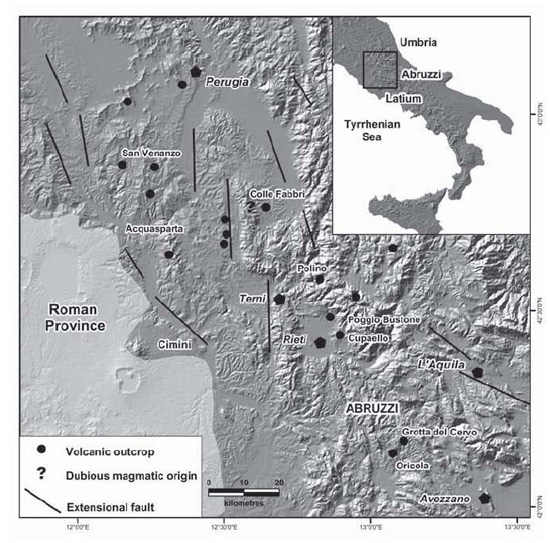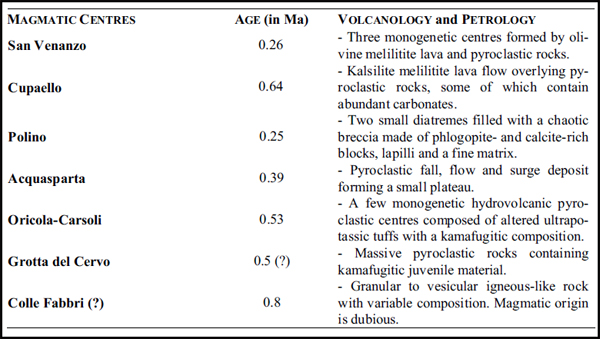The Intra Appennin Province
The internal zones of central Apennines are characterised by thick piles of sedimentary rocks, sitting on the metamorphic basement of the Adriatic plate. Permian-Triassic phyllites and quartzites (Verrucano Group) encountered by borehole drillings represent the oldest rocks in the zone. The Intra-Apennine area was affected by late Triassic to Jurassic rifting, with sedimentation of both complete and reduced successions inside progressively deepening extensional basins.Compressional tectonics related to the formation of the Apennine chain began during the Miocene. The compression front progressively shifted eastward, contemporaneously with terrigenous foredeep sedimentation and with backarc extension. Crustal thickness in the IAP is slightly greater than in Tuscany, increasing across the Apennine chain up to about 35 km, and decreasing towards the Adriatic Sea.

Location of the main outcrops of the Intra-Apennine Magmatic Province. (Peccerillo, 2005).

Petrological characteristics and ages of the main centres of the Intra-Apennine Magmatic Province. (Peccerillo, 2005).
The IAP rocks have an ultrapotassic composition and some types show strong undersaturation in silica, containing melilite and kalsilite Overall, trace element and radiogenic isotope compositions are similar to the Roman Province. Lava flows and dyke rocks are mafic and strongly undersaturated in silica, displaying major element characteristics typical of ultrapotassic rocks with a kamafugitic affinity (Sahama 1974; Gallo et al. 1984; Peccerillo et al. 1988; see Appendix). The pyroclastic rocks range from melilitite to trachyphonolite (Stoppa and Lavecchia 1992), although there are insufficient data to permit a satisfactory petrological and geochemical characterisation of these rocks.
There is a general agreement that the magmatism from the internal zones of Apennines has been generated in anomalous mantle sources, which have been affected by metasomatic enrichment in incompatible elements. However, the nature and timing of mantle metasomatic processes are still debated. Two conflicting hypotheses have been proposed for the genesis of IAP magmas. One suggests source contamination by marly sediments, whereas an alternative hypothesis invokes metasomatic modification by deep mantle material. Mantle contamination by marly sediments requires subduction processes. These could have occurred as a consequence of convergence between the Adriatic plate and the Apennine chain . Such a hypothesis is supported by the presence of a vertical body with high seismic wave velocities beneath the Northern Apennines . This body cuts the asthenosphere and has been interpreted as a relict slab of the Adriatic plate.
Other hypotheses emphasise the coexistence of kamafugites and carbonate-rich rocks, suggesting that these represent a typical association of melilitites and carbonatites, of the same type as those observed in the Virunga province, East Africa. In the view of this hypothesis, the IAP rocks represent a magmatism emplaced in a intra-continental rifting zone .
Bibliography
• Peccerillo. A. Plio-Quaternary Volcanism in Italy. (2005)


